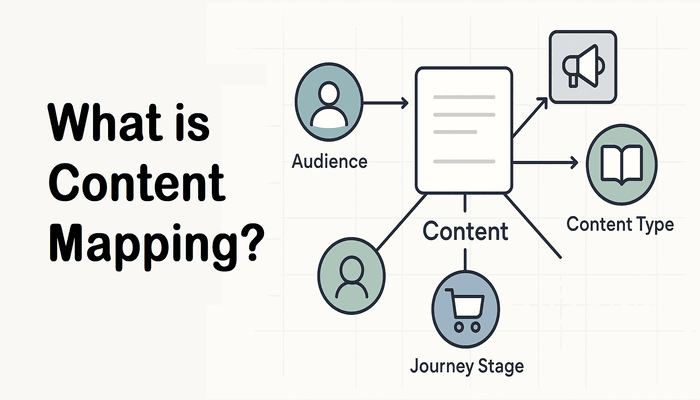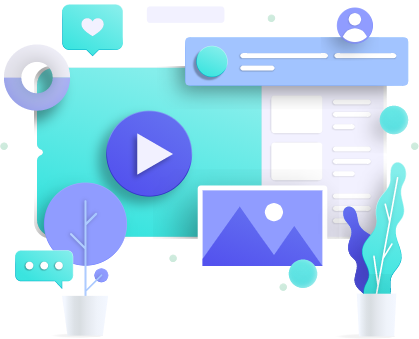Are you spending time creating content only to see little or no impact on your conversions? The issue might not be in the content quality but in the lack of a strategic approach behind it.
Many marketers produce content without a clear strategy for who it is intended for or where it fits in the customer journey. Without a solid plan in place, even the best pieces of content can fall flat.
So, how do you ensure every blog post, email, and offer truly connects with your audience?
That’s what content mapping is all about! In this guide, we will explore it in detail and explain how to create a content map that works—with examples to get you started right away!
What is Content Mapping?
Content mapping is the process of building a content plan that effectively addresses the buyer’s needs at all stages of their lifecycle. Think of it like a roadmap that helps you align content with your audience and gently guide them toward the next step in their buyer journey.
A content plan is built upon the customer’s pain points and their current stage in the lifecycle. A good plan defines the buyer persona and their challenges before mapping content for each stage of the buyer’s journey. It also describes the content type to target with relevant examples for clarity.
Why Should You Create a Content Map?
Content maps help match the right type of content to the right audience at the right time. Ultimately, the goal is simple—create content that truly resonates, encourages action, and boosts your conversions.
1. Share Helpful Content with Your Audience
A study by Datos suggests that 44.19% of Google searches are about brands, and 52.65% of queries had an informational intent. By planning your content thoughtfully, you make it easier for potential customers to find you and get the information they’re looking for.
2. Guide Customers Through Their Journey
According to Neil Patel, almost 96% of website visitors are not ready to buy. Once you get people to discover and interact with your business, you can guide them through their buyer journey by creating content that fits their needs. Whether they’re just learning about you or ready to make a purchase, tailored content can make their experience smoother and more engaging.
3. Mix Up Content Types and Topics
During the process of mapping content, you get to know your audience more deeply. This helps you create a variety of content your audience cares about, such as blog posts, videos, or infographics. This keeps things fresh and increases the likelihood that your prospects will turn into valuable buyers.
How to Build a Content Map Effectively?
Now that you know why content mapping is so important, you’re ready to create a content plan that matches your audience’s needs. To map your content effectively, you need to know who your customers are, what stage they are currently in the buyer journey, and the content that will motivate them to progress further.

Source – Autopilot
Follow this content mapping strategy to create a plan that works.
1. Create Your Buyer Personas
Buyer personas are detailed, fictional profiles of your ideal customers. They help you understand your potential buyers, their challenges, behaviors, and the solutions they seek. Once you understand who your customers are, you can create an effective marketing strategy that resonates and delivers results.
Your knowledge about the audience should include their demographics, hobbies, lifestyle, and values. You also need to know their motivations for buying, pain points, and preferred communication channels, so you can meet them right where they stand.
Tips for Creating a Good Buyer Persona:
- Research your audience thoroughly to understand their needs and challenges.
- Review existing data in reports, studies, and surveys to inform assumptions.
- Test the data through your own polls, interviews, surveys, or feedback loops.
- Research your competitors to identify opportunities for differentiating your brand.
- Categorize your audience into groups based on their purchase behavior, engagement level, and lifecycle stage.
- Create a hypothesis about your buyer personas, leaving room for future modifications.
2. Identify Stages of the Buyer Journey
After you have an accurate customer persona in place, the next step in the content mapping framework is to understand your customer’s lifecycle stages. Once you know where your customer stands in their lifecycle, you can target them with content that encourages them to progress to the next stage, ultimately driving them to make a purchase decision.
Each potential buyer will go through three stages of the marketing funnel before purchasing a product or service from your brand. Together, these stages make up the lifecycle of a buyer.
- Awareness: The customer is aware that they are facing a problem. They cannot completely understand or pinpoint it. However, they are aware of the consequences.
- Consideration: The customer has a complete understanding of their problem. They can name it and are now looking for possible solutions.
- Decision: The customer has found a solution but is debating where to buy it. At this stage, they will be looking to make a purchase from a reliable source.

Source – SmartInsights
3. Map Content for Each Lifecycle Stage
Once you have identified the stages of the buyer journey, you will be able to align the concerns, needs, and goals of your customers to each stage. This knowledge will help you map content to the needs of each buyer persona.
Personalized marketing is becoming increasingly critical. According to HubSpot’s State of Marketing report, 96% of marketers stated that personalized experiences increased sales.
Consider the following questions to personalize content to each stage of the buyer journey.
- What problems or issues are the prospects/customers dealing with?
- Do they have enough resources to handle the issue at hand?
- How can you help address their problem?
- What kind of information do they need from you?
- What type of content would be most suitable for delivering the information?
- Which channels or platforms are they most actively searching on?
Create Content for the Awareness Stage
At this stage, your audience is several steps away from knowing whether a solution exists and where to find it. Instead of presenting your offerings bluntly, step back and meet your audience where they are. Create valuable and comprehensive content that gently informs and guides them to the next step.
That said, the best form of content for the awareness stage includes:
- Blog posts
- Email newsletters
- White papers
- Social media content
- Infographics
- Short videos
Identify Content for Consideration
The consideration content facilitates the customer’s evaluation through solution-focused, detailed information. The goal here is not just to educate them but also to help them pick the best solution through detailed comparisons and reviews. You can also benefit from showcasing your own product or service in a positive light here. But avoid blunt advertisement.
The content for the consideration stage should include:
- In-depth blog posts
- Top list-type articles
- Comparative buying guides
- Case studies and how-to guides
Align Content to Purchase Decisions
Content in the decision stage gives customers the reassurance they need to buy from you. Since they have already undergone the consideration stage, they will be more familiar with the benefits of your products.
All they need is a little push, which will come from tangible evidence in the form of reviews and customer success stories. In fact, a survey by BrightLocal shows that almost 98% of customers read reviews before making a purchase.
Therefore, content types at the decision stage include:
- Customer reviews
- Demos and tutorials
- Product landing pages
- Product feature pages
- Discounts and special offers guide
4. Expand to Website Content Mapping
Now that you’ve got the basics of how to create a content map, it’s time to implement it across your site. Content mapping for a website is the process of evaluating existing content to determine whether it aligns with the needs of prospective buyers at each stage of their purchase journey. Ultimately, it will help you bring not just traffic but also meaningful conversions.
To create a website content map, follow these steps.
- Map Existing Content. Identify all the existing content and see which stage of the customer journey it serves. Organize the content details in a neat spreadsheet. Include specific columns for title, URL, content type, stage of journey, and the targeted persona.
- Access Content Performance: Utilize tools like Google Analytics to determine which content is retaining traffic and where customers are dropping off. Match the underperforming content to the journey stages to identify where you’re lacking.
- Identify Content Gaps. With low-performing content aligned to each stage of the journey, you can quickly identify the culprit behind it. Are there any stage-specific buyer needs or issues your content does not address? Are your competitors addressing the part of the journey with more depth than you?
- Create a Content Plan. After spotting the gaps, build your content plan around them. Fill the gaps with rich, value-driven content in the form preferred by your buyer persona. If your business is targeting multiple personas, prioritize the most profitable ones before moving to the rest.

Source – SEMRush
Content Mapping Tools You Can Try:
Creating a content strategy map does not have to be a technical thing to do. It can be as easy as making a spreadsheet or creating a mind map in any word processor of your choice. But depending on the size of your business, there are some dedicated content planning tools you can use as well.
- Lucidchart: Lucidchart is a cloud-based tool ideal for visually mapping content structures. It has an easy drag-and-drop interface, various templates, and real-time collaboration features. Plus, it offers a free version with limited functions.
- Airtable: Airtable pairs the simplicity of a spreadsheet with the power of a database. It offers customizable templates with rich fields for attachments, checkboxes, and links. It has a free tier with advanced features on paid plans.
- Smaply: Smaply is a paid content mapping software for visualizing customer journeys, personas, and storyboards. It is particularly useful for content mapping tied to user experience. Key features include journey maps and persona templates with collaborative editing.
Content Mapping Examples to Get You Started
Now that you know which tools you can use, let’s help you get started with some examples. If starting from scratch seems daunting, a content map template can provide a structured approach to work.
There are several free and paid website content mapping templates available from reputable sources, including SEMrush, HubSpot, and Ahrefs. You can also create a quick chart in Google Docs for more control over the structure.
Let’s look at the following content map example to understand what to do and how.
Example 1. Online Course Platform for Small Business Owners
Buyer Persona and Pain Points
Persona: Sarah, a small business owner
Challenges:
- Limited time to upskill herself and her staff.
- Budget constraints for professional development.
- Needs practical knowledge that she can apply immediately.
Awareness Stage:
- Prospect’s Situation: Sarah is unaware of how an online course platform can help her business thrive. She’s just beginning to explore options to improve her skills affordably and efficiently.
- Content Types/Topics: (Blog Post) How Online Learning Empowers Small Businesses, (Infographic) Top Skills Every Small Business Owner Needs in 2025”
Consideration Stage
- Prospect’s Situation: Sarah is actively comparing different online course platforms, focusing on course quality, price, and available certifications.
- Content Types/Topics: (Comparison Guide) Best Online Course Platforms for Entrepreneurs, (Case Study) How XYZ Bakery Boosted Revenue Using Online Courses
Decision Stage
- Prospect’s Situation: Sarah has shortlisted a few platforms and needs a final push with real user experiences, ROI demonstrations, and easy signup incentives.
- Content Types/Topics: (Free Trial Offer) Test Drive Our Learning Platform, (Webinar) Maximizing Business Growth With Our Online Courses
Example 2: Home Security System for First-Time Homebuyers
Buyer Persona and Pain Points
Persona: Alex, a first-time homeowner
Challenges:
- Concerned about neighborhood safety.
- Limited knowledge about security tech.
- Wants a budget-friendly and simple DIY solution.
Awareness Stage
- Prospect’s Situation: Alex realizes the importance of home security but doesn’t know what types of systems are available or which features to prioritize.
- Content Types/Topics: (Blog Post) Why Every First-Time Homebuyer Needs a Security System, (Checklist) Essential Home Safety Tips for New Homeowners
Consideration Stage
- Prospect’s Situation: Alex is comparing different home security systems, focusing on smart integration, ease of installation, and affordability.
- Content Types/Topics: (Comparison Chart) Top DIY Home Security Systems Ranked, (eBook) Beginner’s Guide to Smart Home Security
Decision Stage
- Prospect’s Situation: Alex is ready to make a purchase but needs confirmation through demos, customer reviews, and clear pricing information.
- Content Types/Topics: (Demo Video) Installing Your New Home Security System in Under 30 Minutes, (Pricing Guide) Affordable Security Plans Tailored for First-Time Buyers
Final Words
Content mapping makes it easy to bring the right type of traffic to your website. All you need to do is identify your buyer personas and align your content to their unique needs. By tailoring content to your audience and their lifecycle stage, you get closer to winning a loyal following of customers. Use our content map guide and examples to inform your content planning journey—and start converting prospects into valuable buyers!





